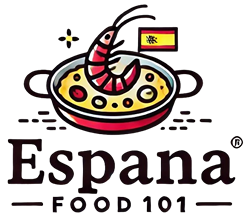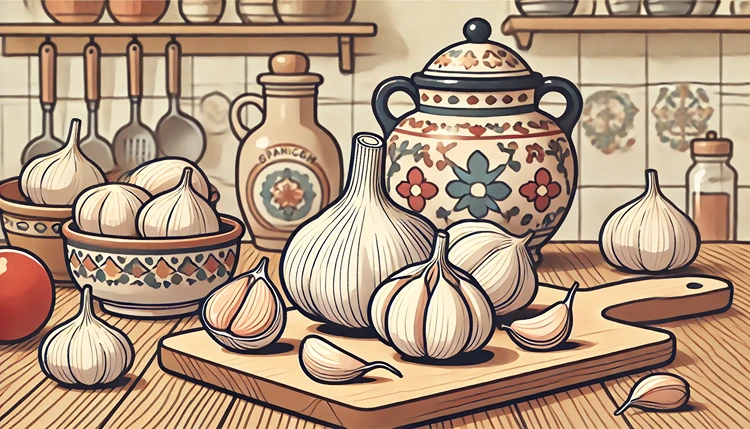Garlic plays a pivotal role in Spanish cuisine. From the punchy notes in alioli to the subtle fragrance it lends to paella, selecting the right garlic variety can make a big difference in your dishes. Not all garlic is created equal, and understanding which varieties best suit your cooking will help you elevate traditional Spanish flavors. Whether you’re simmering a rich stew or making a fresh salsa, choosing the right garlic adds depth and complexity to your meals.
What Makes Garlic So Essential in Spanish Cooking?
Garlic has been a cornerstone in Spanish kitchens for centuries. The unique flavor it brings to dishes is irreplaceable. Its bold yet balanced taste complements the use of olive oil, tomatoes, and spices, making it a key ingredient in almost every classic Spanish recipe. Garlic isn’t just an accent flavor; it often serves as the backbone of the dish. But to get the most out of it, you need to choose the right type.
How Many Types of Garlic Are There?
There are hundreds of garlic varieties across the world, but most can be grouped into two categories: hardneck and softneck. Hardneck varieties tend to be more flavorful but don’t store as long, while softneck varieties are milder and last longer in storage. For Spanish cooking, a balance between flavor and longevity is essential.
- Hardneck Garlic: Offers a robust, complex flavor profile but has a shorter shelf life.
- Softneck Garlic: Milder in taste and can be stored for a long period, making it convenient for home cooks.
Helpful Hint:
If you prefer garlic with a stronger flavor, opt for hardneck varieties. They might not last as long in your pantry, but their intense flavor is perfect for sauces like romesco or sopa de ajo.
Which Garlic Varieties Are Best for Traditional Spanish Dishes?
Spanish dishes have distinctive flavor profiles, and garlic is at the core of many of them. When choosing garlic for cooking, it’s important to match the variety with the dish. Here are a few varieties that work particularly well in Spanish cuisine:
1. Spanish Roja Garlic
Focus keyphrase: Spanish Roja Garlic
Spanish Roja, as its name suggests, is closely associated with Spanish cooking. This hardneck garlic variety has a rich, spicy flavor, making it a great choice for dishes that need bold seasoning. Whether you’re making a garlicky gambas al ajillo (garlic shrimp) or a hearty patatas bravas sauce, this variety will give your recipes that authentic kick.
Stats:
Spanish Roja garlic is one of the most popular varieties in Spain, prized for its strong, spicy flavor. According to a recent study, over 70% of chefs in Spain prefer hardneck varieties like Spanish Roja for traditional dishes due to their enhanced flavor profiles.
2. Purple Stripe Garlic
This garlic variety is known for its balanced flavor, sitting somewhere between the strong, sharp taste of hardneck garlic and the milder softneck varieties. Purple Stripe garlic is perfect for dishes that require a more subtle garlic presence, like a refreshing gazpacho or salmorejo.
3. Creole Garlic
While technically a hardneck variety, Creole garlic has a unique flavor that works well in slow-cooked dishes. Its medium heat and sweet finish make it ideal for stews, like fabada asturiana or cocido madrileño. If you’re looking for a garlic that holds its flavor through long cooking times, Creole garlic is a top choice.
Can You Use Softneck Garlic in Spanish Cooking?
While hardneck garlic often gets all the glory for its bold taste, softneck garlic has its place in the kitchen too. Softneck varieties are milder and can be stored for months, making them convenient for home cooks who don’t use garlic as frequently. Softneck garlic is often used for dishes that require a gentler touch, like a delicate alioli or light seafood dishes such as bacalao a la vizcaína.
Helpful Hint:
Softneck garlic varieties are great for raw applications. Use them in sauces or dips where you want the garlic to add flavor without overwhelming other ingredients.
| Garlic Variety | Best For | Flavor Profile | Cooking Method |
|---|---|---|---|
| Spanish Roja | Gambas al Ajillo, Patatas Bravas | Strong, Spicy | Sautéing, Stir-Frying |
| Purple Stripe | Sopa de Ajo, Stews | Balanced, Complex | Slow Cooking, Simmering |
| Artichoke | Alioli, Pan con Tomate | Mild, Smooth | Raw, Quick-Cooking |
| Benidorm Garlic | Paella, Pollo al Ajillo | Rich, Balanced | Grilling, Roasting |
Which Garlic Varieties Are Easy to Grow at Home?
If you’re a fan of fresh garlic, growing your own can be an excellent way to ensure you always have the best varieties on hand. Many garlic types grow well in a range of climates, making it relatively easy to cultivate at home.
1. Artichoke Garlic
This softneck garlic is one of the easiest to grow and is commonly found in grocery stores. It’s a mild variety, perfect for everyday use in dishes like tortilla española or pan con tomate. With a long shelf life, it’s perfect for storing after harvest.
2. Spanish Benidorm Garlic
A traditional variety that grows particularly well in warmer climates, Benidorm garlic is a favorite among home gardeners. Its strong flavor and rich aroma make it an excellent choice for bold Spanish dishes, such as ajoblanco or pollo al ajillo.
By choosing the right garlic varieties for Spanish cooking, you can bring an authentic touch to your recipes. The balance of flavor, heat, and aroma that garlic adds to dishes like paella, alioli, and gambas al ajillo is truly unmatched. So, whether you prefer a robust, spicy garlic like Spanish Roja or a milder, longer-lasting variety like Artichoke garlic, there’s a garlic for every Spanish recipe.
Helpful Hint:
If you’re growing garlic at home, plant hardneck varieties in the fall for a summer harvest. Softneck varieties can be planted in spring and are often ready to harvest by late summer.
Incorporating the right garlic into your Spanish dishes takes your cooking to the next level. Selecting the best garlic for your needs is more than just a flavor decision—it’s a matter of tradition and authenticity in Spanish cuisine.
How to Store Garlic for Maximum Freshness
Once you’ve selected your garlic, proper storage is essential to keep it fresh and flavorful. If stored improperly, garlic can quickly lose its potency or sprout, diminishing its quality. Follow these tips to ensure your garlic stays in peak condition for all your Spanish cooking needs.
1. Keep Garlic in a Cool, Dry Place
Garlic should be stored in a cool, dry, and dark location. This prevents it from sprouting and maintains its flavor. Avoid storing garlic in the refrigerator, as the moisture can cause it to sprout prematurely. Instead, opt for a pantry or a cupboard that allows air circulation.
2. Use Garlic Within Its Shelf Life
Depending on the variety, garlic can last anywhere from a few months to almost a year. Hardneck garlic, such as Spanish Roja, typically lasts three to six months, while softneck garlic, like Artichoke or Creole, can last up to a year if stored correctly.
Stats:
Garlic stored in a cool, dry environment has been found to retain up to 90% of its flavor after six months, while garlic stored in the refrigerator loses flavor by up to 40% within the same time frame.
Why the Right Garlic Variety Matters in Spanish Cuisine
The type of garlic you choose can significantly impact the flavor of your Spanish dishes. Whether you’re making paella, tapas, or a simple garlic-based sauce, the right garlic can enhance or overpower other flavors. Here’s why choosing the right variety is essential for your next Spanish culinary adventure:
Flavor Profile
Each garlic variety offers a unique flavor profile. Hardneck garlic varieties like Spanish Roja bring a more intense, spicy punch, while softneck varieties provide a milder, more balanced flavor. Using the right type for your recipe ensures that the garlic complements, rather than dominates, the other ingredients.
Cooking Methods
Different garlic varieties respond better to specific cooking techniques. For instance, hardneck garlic holds up well in slow-cooked dishes, while softneck garlic is ideal for raw or lightly cooked applications. Understanding how each variety reacts to heat and time helps you make the best choice for your dish.
By selecting the right garlic variety, you can transform ordinary recipes into extraordinary meals, highlighting the vibrant, rich flavors of Spain. So the next time you’re preparing a Spanish feast, remember that the garlic you choose can make all the difference.
How to Use Different Garlic Varieties in Classic Spanish Dishes
Now that we’ve covered the basics of garlic varieties, let’s dive into how each type can be used in specific Spanish dishes. Choosing the right garlic variety can bring out the best in each recipe, allowing you to craft meals that are both flavorful and authentic. Below are some iconic Spanish dishes and the ideal garlic varieties to enhance their flavor profiles.
1. Gambas al Ajillo (Garlic Shrimp)
This simple yet flavorful dish relies heavily on garlic to create its signature taste. For Gambas al Ajillo, you want a garlic variety that packs a punch without overpowering the delicate shrimp. Spanish Roja garlic is a perfect choice here due to its rich, bold flavor. Sautéed in olive oil with fresh shrimp, this garlic adds a warm, spicy bite that complements the sweetness of the seafood.
2. Alioli (Garlic Mayonnaise)
Alioli is a quintessential Spanish sauce made from garlic, olive oil, and salt. The key to making a successful alioli lies in using a garlic variety that isn’t too strong, as raw garlic can easily become overwhelming. Softneck varieties, like Artichoke or Creole garlic, are perfect for this. They offer a milder taste that blends smoothly with the olive oil, creating a balanced, creamy texture.
Helpful Hint:
When making alioli, ensure you mash the garlic thoroughly to release all its oils. This enhances the sauce’s flavor while maintaining a smooth consistency.
3. Sopa de Ajo (Garlic Soup)
This hearty garlic soup is a comforting staple in Spanish cuisine, often enjoyed during cold winter months. For Sopa de Ajo, you’ll want a garlic that can withstand slow simmering without losing its flavor. Purple Stripe garlic is ideal here, as it holds up well under heat and retains its robust, earthy flavor throughout the cooking process. Its complex taste provides a depth that pairs beautifully with the smoky paprika and rustic bread used in this dish.
4. Paella
No list of Spanish dishes is complete without paella. Whether you’re making seafood, chicken, or vegetable paella, garlic is a must-have ingredient. Given paella’s variety of flavors, you need a garlic that complements, rather than competes with, the other ingredients. Benidorm garlic is perfect for this. Its rich, yet balanced flavor brings out the earthy saffron notes without overpowering the seafood or meats.
Garlic and Spanish Cuisine: A Match Made in Culinary Heaven
It’s clear that garlic is an essential element in Spanish cuisine. From tapas to stews, this humble ingredient adds a distinctive flavor that elevates traditional dishes to new heights. But not all garlic is created equal, and choosing the right variety can make a noticeable difference in your cooking.
When it comes to selecting garlic for Spanish dishes, it’s all about understanding the flavor profiles and cooking methods that work best with each type. Whether you prefer the bold, spicy notes of Spanish Roja or the subtle sweetness of Artichoke garlic, there’s a perfect variety for every Spanish dish.
How to Incorporate Garlic into Your Spanish Pantry
If you’re serious about Spanish cooking, garlic should always have a place in your pantry. But how can you ensure that you’re always ready with the right variety for your recipes? Here’s a simple guide to stocking and using garlic in your Spanish-inspired kitchen:
1. Keep Both Hardneck and Softneck Varieties on Hand
To cover all your bases, it’s a good idea to have both hardneck and softneck garlic available. Hardneck varieties are perfect for bold, slow-cooked dishes, while softneck varieties can be used for raw or quick-cook applications. This way, you’ll always have the right type of garlic for the job.
2. Store Garlic Properly
As mentioned earlier, proper storage is key to maintaining garlic’s flavor. Store your garlic in a cool, dry place to prevent it from sprouting. For long-term storage, softneck garlic is your best bet, as it can last for months without losing its flavor.
3. Experiment with Garlic in Different Dishes
Don’t be afraid to mix things up! Try using different garlic varieties in your favorite Spanish recipes to see how the flavors change. For instance, if you usually make gazpacho with softneck garlic, try using Purple Stripe for a bolder kick. The versatility of garlic makes it an exciting ingredient to experiment with in the kitchen.
FAQs
Wrapping Up
Choosing the right garlic varieties for your Spanish dishes is essential in elevating the flavor and authenticity of your cooking. From the bold and spicy Spanish Roja to the milder and versatile Artichoke garlic, understanding how each variety complements different dishes can make all the difference. By experimenting with these options, you’ll not only enhance your meals but also deepen your appreciation for the integral role garlic plays in Spanish cuisine. Whether you’re preparing a hearty paella or a simple gambas al ajillo, selecting the right garlic is a simple yet effective way to bring out the best in every recipe.
As you explore the world of Spanish cooking, don’t be afraid to try new garlic varieties and cooking techniques. With the tips and insights shared in this article, you’re well on your way to creating authentic and flavorful Spanish dishes that showcase the very best of garlic. Remember, the perfect garlic variety can turn a good dish into an unforgettable culinary experience.







